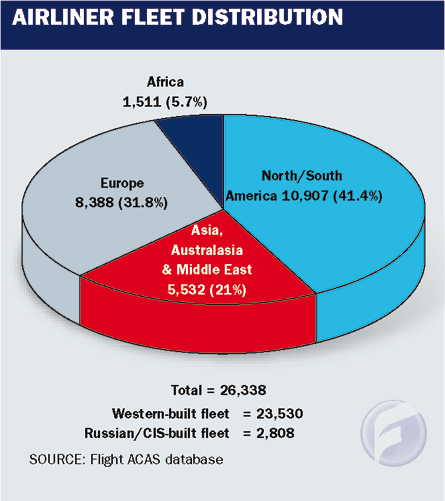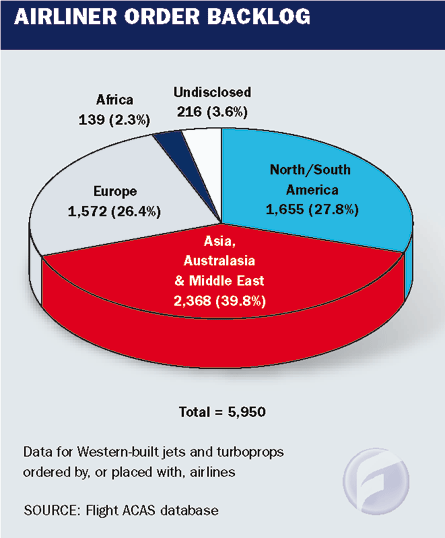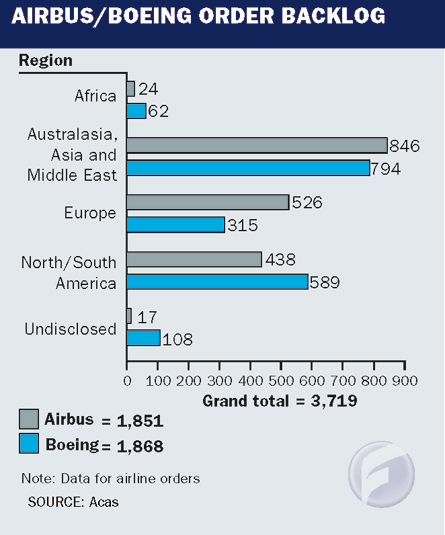Our annual census of the world’s airliners reveals that after two years of slow growth, the rate of expansion is once again on the increase
The expansion rate of the world’s airliner fleet has increased over the past 12 months after two successive years of reduced growth.
Compiled from Flight’s ACAS database, this year’s edition of our annual World Airliner Census comprises some 26,200 aircraft - 2.4% more than last year’s edition. The Western types have been driving growth, with the fleet expanding by 2.9% to 23,400 units. However, the number of Russian and CIS-built aircraft declined again - this time by 1.6% - to fewer than 2,800 aircraft.

Overall fleet growth fell to 1.8% in last year’s census (with Western growth at 2.1%) and this followed several years of declining growth. So the 2.4% recorded this year represents a turnaround.

Deliveries over the past 12 months total 1,087 aircraft - up 13% on the same period between 2005 and 2006. However, ACAS records only two Russian airliner deliveries during the past 12 months.
Retirements from the fleet have increased by a third, from 235 aircraft last year to over 300. Among these are the first Boeing 777s, with at least one early-build ex-British Airways low-gross-weight 777-200 earmarked for “spares recovery” - the polite jargon for “broken up”.
While North/South America remains the leader in the fleet distribution chart, its share has declined a percentage point this year from 42.4% to 41.4%. The decline has been driven by slight gains by all the other three regions.

While the airlines of Africa have the ignominy of having the world’s oldest average fleet age - at 20 years - unsurprisingly it is Asia that boasts the youngest - at nine years. These compare with a world average of 14 years. Europe’s fleet is the second youngest, with an average age of 12 years.
POPULAR A320
The Airbus A320 retains its position as the single most numerous aircraft family with the fleet having broken through the 3,000 unit barrier this year. Runner-up again is the first of the three 737 families - the next generation -600 to -900 models - with almost 2,200 aircraft in service. The CFM56-powered 737 Classic retains its third position, and the number qualifying for the census actually increased this year as aircraft returned to service with airlines. The combined 737 fleet continues to grow, this year reaching the 4,500 aircraft mark.

The big mover this year is the 777, the fleet of which has increased by over 11% and moved it off the bottom of the ranking into a solid eighth place.
On the face of it, the regional fleet top 10 looks little changed, with the familiar ranking headed by the 50-seat jets - the Bombardier CRJ100/200 at the head of the table and the Embraer ERJ runner-up. However, the significant development is the surge in growth of the two in-production turboprop types - the Dash 8/QSeries and ATR 42/72 - which have each seen over 5% increases as demand for propeller-driven aircraft rebounds.
With one exception, the types in the Russian/CIS top 10 are all showing declines this year, although the order ranking is unchanged from 2006.
The world airliner order backlog has increased by more than a third this year to almost 6,000 aircraft. The dominant region remains Asia, Australasia and the Middle East, although its share has declined slightly this year. North/South America has fallen two percentage points at the expense of Europe, which has recorded a two percentage point increase.
At 4,950 aircraft, Airbus and Boeing’s orders combined represent more than 80% of the total. Again the orders have ballooned by 30% over the past 12 months.
Honours are split almost evenly between the two, with Airbus holding a slim advantage. The European airframer leads in the biggest market - Asia, Australasia and Middle East - with a 55% share, but the positions are reversed in North America where Boeing is ahead. Competition is fairly even in Europe.
The idle airliner fleet situation is gradually improving as aircraft are either returned to service or broken for spares. The parked fleet is heading south of 2,000 aircraft for the first time since before 9/11. The proportion of the total in-service fleet is hovering around the 10% figure - having expanded as high as 12.5% after the 2001 inspired glut. However, the parked fleet is around double size it was at the turn of the decade.
BOEING DOMINANCE

The manufacturers’ ranking is still dominated by the almost 11,000 Boeings in service, but the US airframer’s share has remained constant at around 47%. While the Boeing total grew by on 2% as retirements offset the large number of new aircraft entering the fleet, Airbus recorded a 10% growth to 4,500 aircraft. This gives it nigh on 20% market share for the first time.
The significant ranking change is ATR, which has seen almost 6% growth and moved ahead of BAE Systems into sixth place, with its fleet increasing to 640 aircraft.
This year’s world airliner census is available to download in pdf format …
Source: Flight International
















